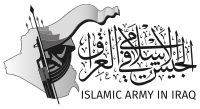
Back الجيش الإسلامي في العراق Arabic İraq İslam Ordusu Azerbaijani Ісламская армія ў Іраку Byelorussian سوپای ئیسلامیی لە عێراق CKB Islamische Armee im Irak German Ejército Islámico en Irak Spanish Irakin islamilainen armeija Finnish Armée islamique en Irak French Islamska Armija u Iraku Croatian Esercito islamico dell'Iraq Italian
This article is missing information about the group from after 2014. (January 2018) |
| Islamic Army in Iraq الجيش الإسلامي في العراق | |
|---|---|
 | |
| Leaders | Ishmael Jubouri Muhammad Abid Luhaibi Ahmed al-Dabash |
| Dates of operation | 2003–2014? |
| Active regions | Sunni Triangle Baghdad Belts |
| Ideology | Sunni Islamism Jihadism Anti-Imperialism Anti-Zionism |
| Size | 10,400 (2007)[1] |
| Allies | |
| Opponents | |
| Battles and wars | Iraq War Iraqi insurgency (2011–2013) |
| Flag |  |
The Islamic Army in Iraq (Arabic: الجيش الإسلامي في العراق, romanized: al-Jaysh al-Islāmi fī'l-`irāq, abbr. IAI) was one of a number of underground Islamist militant (or mujahideen) organizations formed in Iraq following the 2003 invasion of Iraq by U.S.-led Coalition forces, and the subsequent collapse of the Ba'athist regime headed by Saddam Hussein. IAI was regarded as one of the largest, sophisticated and most influential Sunni insurgent groups in Iraq that led an asymmetrical military insurgency against Coalition forces.[2] The group became known for its grisly videos of kidnappings and attacks on U.S. and Iraqi troops.[3]
Although it carries an Islamic title, the group combines Sunni Islamism with Iraqi nationalism, and has been labelled as "resistance" by Iraq's Sunni Vice president Tariq al-Hashimi (sentenced to death in 2012) despite al-Hashimi's close relations with the U.S. government.
Following the withdrawal of American forces from Iraq in late 2011, the IAI demobilized and turned towards political activism, setting up the Sunni Popular Movement.[4] The group’s turn away from armed opposition towards activism was criticised by other militant groups, including groups that the IAI had previously allied with such as the Mujahideen Army.[4]
In the beginning of 2014, however, the group has been active in the ongoing anti-government violence in Anbar and Northern Iraq. The group was primarily active in the Diyala and Saladin Governorates.[4] Most of its fighters have renounced fighting against the Iraqi state, although some have joined ISIS. Islamic Army in Iraq has not claimed any attacks since late 2014.
On the 9th of April, 2024, the group has published a video titled "Come to Jihad" (حي على الجهاد). This hour long video shows the history of activities the group was involved in and testifies that the group will come back. Furthermore, the group reannounces their opposition towards the Iranian government and ISIS. They also call for the Sunni Iraqis to join the group.[5]
- ^ Daniel Cassman. "Islamic Army in Iraq | Mapping Militant Organizations". Stanford.edu. Retrieved 2012-09-14.
- ^ Acun, Can (July 2014). "The Map of Insurgency in Iraq: The Armed Groups" (PDF). SETA (Foundation for Political, Economic and Social Research).
- ^ Abdel-Hamid, Hoda (2006-11-20). "Inside the Islamic Army of Iraq". Al Jazeera.
- ^ a b c al-Tamimi, Aymenn Jawad (1 July 2014). "Iraq crisis: Key players in Sunni rebellion". BBC News.
- ^ الجيش الاسلامي في العراق (2024-04-09), حي على الجهاد, retrieved 2024-04-17
© MMXXIII Rich X Search. We shall prevail. All rights reserved. Rich X Search